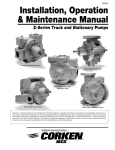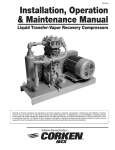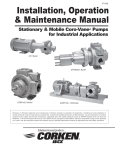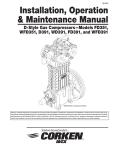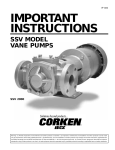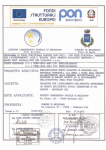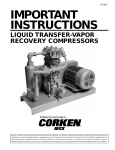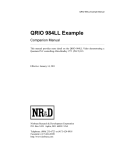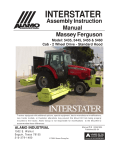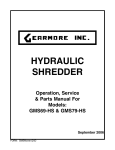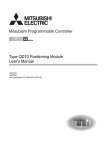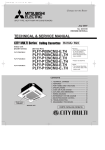Download Installation, Operation & Maintenance Manual
Transcript
ID107D Installation, Operation & Maintenance Manual PZ-Series Coro-Vane® Petroleum Pump For Refined Petroleum Products and Industrial Solvents PZ7 Model with Standard Bypass Valve Warning: (1) Periodic inspection and maintenance of Corken products is essential. (2) Inspection, maintenance and installation of Corken products must be made only by experienced, trained and qualified personnel. (3) Maintenance, use and installation of Corken products must comply with Corken instructions, applicable laws and safety standards (such as NFPA Pamphlet 58 for LP-Gas and ANSI K61.1-1972 for Anhydrous Ammonia). (4) Transfer of toxic, dangerous, flammable or explosive substances using Corken products is at user’s risk and equipment should be operated only by qualified personnel according to applicable laws and safety standards. Warning Install, use and maintain this equipment according to Corken’s instructions and all applicable federal, state, local laws and codes. Periodic inspection and maintenance is essential. Corken One Year Limited Warranty Corken, Inc. warrants that its products will be free from defects in material and workmanship for a period of 12 months following date of purchase from Corken. Corken products which fail within the warranty period due to defects in material or workmanship will be repaired or replaced at Corken’s option, when returned, freight prepaid to CORKEN, INC., 3805 N.W. 36th Street, Oklahoma City, Oklahoma 73112. Parts subject to wear or abuse, such as mechanical seals, vanes, piston rings, packing and other parts showing signs of abuse are not covered by this limited warranty. Also, equipment, parts and accessories not manufactured by Corken but furnished with Corken products are not covered by this limited warranty and purchaser must look to the original manufacturer’s warranty, if any. This limited warranty is void if the Corken product has been altered or repaired without the consent of Corken. All implied warranties, including any implied warranty of merchantability or fitness for a particular purpose, are expressly negated to the extent permitted by law and shall in no event extend beyond the expressed warranty period. Corken disclaims any liability for consequential damages due to breach of any written or implied warranty on Corken products. Transfer of toxic, dangerous, flammable or explosive substances using Corken products is at the user’s risk. Such substances should be handled by experienced, trained personnel in compliance with governmental and industrial safety standards. Contacting the Factory Before you contact the factory, note the model number and serial number of your pump. The serial number directs us to a file containing all information on material specifications and test data applying to your specific pump. When ordering parts, the Corken service manual or IOM (Installation, Operations and Maintenance) manual should be consulted for the proper part numbers. ALWAYS INCLUDE THE MODEL NUMBER AND SERIAL NUMBER WHEN ORDERING PARTS. The model and serial numbers are shown on the nameplate of the unit. Record this information for future reference. Model no. _______________________________________________________________________________________ Serial no. ________________________________________________________________________________________ Date purchased ___________________________________________________________________________________ Date installed _____________________________________________________________________________________ Purchased from ___________________________________________________________________________________ Installed by _______________________________________________________________________________________ 2 Table of Contents Principles of the PZ-Series Pump ................................................................................................................................... 4 Exclusive Features of PZ-Series Pump .......................................................................................................................... 4 Installation of the PZ-Series Pump ................................................................................................................................. 4 Operation of the PZ-Series Truck Pump ......................................................................................................................... 5 Maintenance of Your Pump System ................................................................................................................................ 6 Pump Maintenance Schedule ...................................................................................................................................... 6 Disassembly and Assembly Instructions for the PZ-Series Pump ................................................................................... 6 Disassembly Instructions ............................................................................................................................................. 6 Assembly Instructions ................................................................................................................................................. 7 Mechanical Seal and Vane Replacement Instructions .................................................................................................... 8 Cleanliness and Workmanship .................................................................................................................................... 8 Lubrication ................................................................................................................................................................... 9 Repair Kits for the PZ-Series ........................................................................................................................................ 10 Appendix A—Model Number and Indentification Code ................................................................................................. 11 Appendix B—Technical Specifications .......................................................................................................................... 12 Appendix C—Performance Curves ............................................................................................................................... 13 Appendix D—Outline Dimensions for the PZ7 .............................................................................................................. 15 Appendix D—Outline Dimensions for the PZ10 ............................................................................................................ 16 Appendix D—Outline Dimensions for the Air Operated Valve (AOV) and Strainer ........................................................ 17 Appendix E—Parts Details for the PZ7 with the Standard Bypass Valve ....................................................................... 18 Appendix E—Parts Details for the PZ10 with the Standard Bypass Valve ..................................................................... 19 Appendix E—Parts Details for the PZ7 Air Operated Valve (AOV) ................................................................................ 20 Appendix E—Parts Details for the PZ10 Air Operated Valve (AOV) .............................................................................. 21 Appendix E—Parts Details for the Strainer ................................................................................................................... 22 Appendix F—Trouble Shooting Guide for the PZ-Series Pump .................................................................................... 23 Appendix G—Flush and Storage Instructions for the PZ-Series Pump ......................................................................... 24 3 Principles of the PZ-Series Pump The PTO SELECTION is important. The pump requires a PTO with an average output speed of 500 to 700 RPM for maximum performance when the truck engine is operating at the proper speed to maintain oil pressure and water circulation. The PZ-Series pump is a special type of rotary positive displacement pump, known as a sliding vane pump. THE DRIVESHAFT connecting the pump to the PTO should be of the “splined” or slip type. This type driveshaft permits the shaft to adjust for PTO movement and twisting of the truck frame. A fixed driveshaft transfers the forces directly into the pump and PTO and will shorten the life of both considerably. The yokes of the driveshaft universal joints must be positioned as shown on page 5, Figure 1. Improper positioning will soon wear them out and potentially destroy the bearings in the pump and PTO. The sliding vane pump has many of the positive displacement advantages of the gear pump, plus the ability to compensate for wear, and operate at a lower noise level. The sliding vane pump consists of a rotor turning in a cam machined eccentrically in relation to the rotor; thereby displacing the liquid trapped between the rotor, cam and vanes. The PZ-Series pumps are made with vanes produced from advanced polymers which exhibit extremely low coefficients of friction. The vanes are self-adjusting for wear which gives the pump long life. INLET PIPING should be as short as possible and at least the minimum diameter specified for the model with minimum restrictions so that the pressure drop is limited. Exclusive Features of the PZ-Series Pump The outlet piping should include the following: 1. A pressure gauge should be installed in the pump outlet or near it. A pressure gauge is necessary to determine the efficiency of your pumping system. The pumping of volatile liquids is one of the most difficult of all pumping jobs, and pumping from a delivery truck makes it even more difficult, so more attention must be given to the design and manufacturing of the pump and to its installation and operation. 2. If a meter with an air eliminator is installed, never pipe the eliminator directly into the pump inlet piping or into the liquid part of the system at any point (refer to the meter installation manual). In addition to being especially suited for handling volatile liquids, your PZ-Series pump has a number of features to help make it more easily operated and maintained. 3. The discharge piping should be at least the same size as the meter piping. The CASE and HEADS are made of Ductile Iron, not Cast Iron, for extra strength and toughness. Power Take-Off Drive Systems Proper pump operation and long life is directly dependent upon a good drive system. Many truck pumps utilize a power train consisting of shafts and universal joints from a power take-off shaft on the truck engine to the pump. The VANES are manufactured of advanced polymers to provide excellent life and quiet operation. After long service, the vanes are simply and inexpensively replaced. SIDEPLATES may be reversed for extended service life. The sideplates are easily replaced should the need arise. There are several basic principles that should be followed in laying out a PTO drive. These principles should not be violated to produce a workable power train that results in long pump life and reduced drive wear. THE MECHANICAL SEAL is designed for longer life under greater loads and may be inspected or replaced without disturbing the piping of the pump. No special tools are needed. First, the driver shaft and the driven shaft must be parallel to one another within plus or minus one degree. Improper alignment will cause jerking and back and forth “whip” to the pump shaft, thereby imparting a surging pulsation to the liquid flow, which results in noise, vibration and abnormal wear. BEARINGS are heavy-duty roller type for long bearing life. THRUST BEARINGS are heavy-duty needle roller type rated for 4,000 lbs. Second, the angle of the ‘’floating’’ shaft should be within the limits for the particular equipment being used (usually a maximum of 15° at pump speeds up to 800 RPM). To ensure that shaft expansion or contraction does not distort the drive system, a splined slip joint should be placed between the two universal joints. The drive shaft should be of the “splined” or slip type to permit the shaft to adjust for PTO movement and twisting of the truck frame. A fixed drive shaft transmits the forces directly to the pump and PTO which will shorten the life of both considerably. NONMETALLIC VANE DRIVERS do not penetrate the vanes like the conventional steel vane drivers. Available with adjustable internal BYPASS VALVE or optional AIR OPERATED VALVE (AOV) for high and low flow control. Installation of the PZ-Series Pump The mechanical installation of the PZ-Series pump is a simple matter. A rotation arrow is located on the side of the pump so check the PTO to determine its direction of rotation. The PZ-Series pump will match either PTO rotation. Connect the drive shaft to the pump shaft that turns the pump in the direction of the arrow. Third, the yokes of the drive shaft universal joints must be in a parallel position. Figure 1 on page 5 illustrates the proper arrangement of the yokes. 4 Improper installation of the U-joints will soon destroy them along with the bearings in the pump and PTO. Properly mounted, the second universal gives uniform motion to the drive shaft by compensating for the rotational error introduced by the first U-joint. An even number of universal joints (2, 4, 6 etc.) should always be used. An odd number of U-joints will cause unbalanced pump shaft rotation. This problem becomes greater with increased angularity. 3. Check the discharge pressure on the outlet of the pump. This pressure is typically set at 80 to 95 psi. 4. Standard Bypass Valve For a standard bypass valve, locate the adjustment set screw under the adjustment set screw cap (see parts details on pages 18 and 19). Turn adjustment screw clockwise to increase pressure and flow. Turn counter clockwise to decrease pressure and flow. Other points to consider include the proper sizing of the shaft components with a maximum horsepower load to be expected, good alignment of hanger bearings and proper pump coupling alignment. Close nozzle and check bypass pressure. If too high, turn adjustment screw counter clockwise until desired pressure is reached. Improper PTO systems account for a high percentage of truck pump failures. Always remember to disengage the clutch before shifting the PTO into gear. Shifting the PTO into gear without disengaging the clutch imparts an enormous shock on the PTO, drive shaft, pump and meter and will soon damage one or all of them. With the hose nozzle open, adjust the pump bypass valve setting to the desired flow rate. Close the nozzle slowly and check the system pressure. CAUTION: DO NOT EXCEED A CLOSED NOZZLE PRESSURE OF 125 PSI. Replace adjustment set screw cap with seal washer and tighten. For proper installation of pump drives, follow the rules listed below: 5. Air Operated Valve (AOV) assembly For pumps equipped with an Air Operated Valve (AOV) assembly, air must be supplied from the truck air system via a flow sensing valve. Approximately 70 psi (4.8 bar) minimum air pressure is required to properly operate the air operated valve. THE AIR PRESSURE MUST NOT EXCEED 125 psi (8.6 bar). The sensing valve should be installed in accordance with the diagram shown in Figure 2. This system depicts the additional use of a throttle control which is optional. All adjustments must be made at normal operating speeds. 1. Driver shaft and pump shaft must be parallel, plus or minus one degree. 2. Operating angle of the ‘’floating’’ shaft must be 15° maximum. 3. Universal yokes must be in line and parallel. 4. Splined slip joints must be used where needed. 5. Use an even number of universal joints. 6. Always use the least practical number of shafts. 5.1 Set the low pressure adjustment first by slowly closing the nozzle to relieve the air pressure in the AOV assembly. 5.2 Remove the adjustment stem cap and O-ring (see parts details on pages 20 and 21). Figure 1, Shaft alignment PTO selection and drive system design is extremely important. The PTO should have an average output speed up to 800 RPM to maximize the performance of the PZSeries pump when the truck engine is operating at the recommended speed. The designer of the drive system must select a PTO drive shaft capable of meeting the torque requirements of the pumping system. Operation of the PZ-Series Pump Truck Pump The following steps should be performed for the initial pumping operation: 1. Close the shutoff valve on the end of the delivery hose. 2. Start the pump and cycle the nozzle open and closed to clear all air from the system. Figure 2, Typical truck delivery system using an AOV. 5 5.3 Turn the low pressure adjustment bushing counterclockwise to decrease the bypass pressure and vice versa to increase the pressure (see parts details on pages 20 and 21). 5.4 Re-install the O-ring and adjustment stem cap and tighten securely. 5.5 Open and close the nozzle several times to ensure proper setting and repeatablility. 5.6 Slowly close the delivery nozzle again to relieve the air pressure in the AOV assembly. 5.7 Remove the adjustment stem cap and O-ring. 5.8 Adjust the locknuts clockwise to decrease delivery flow rate and/or pressure and vice versa to increase the flow rate. NOTE: Make sure the locknuts are securely locked against each other before re-installing the adjustment stem cap and O-ring. 5.9 Bearing Lubrication There are two lubrication points in which to grease the pump bearings; one zerk per bearing cap located at opposite ends of the pump. Four grease relief and seal ventilation fittings have been provided, two at each end of the pump, to help prevent over greasing the bearings. Over greasing can cause seal failure if grease passageways are blocked in some way. Remove relief fittings or confirm free movement of relief prior to greasing bearings. Clean each fitting before lubricating the bearings. This practice helps to prevent foreign material contamination of the bearings and accidental overpressurization of the mechanical seals. Use only Ball Bearing Grease (MIL-G-10924C) with a temperature rating of -70°F. Normal wear parts are the mechanical shaft seals, bearings, vanes, vane drivers and sideplates. All of these parts plus O-rings and grease seals are offered in the “repair kit.” Use only genuine Corken replacement parts when repairing your PZ-Series pump. Follow the instructions provided with the parts. Slowly open the delivery nozzle and note delivery flow rate and/or pressure. When it becomes necessary to repair your pump or remove it from the system, you must be absolutely certain that all product being pumped is bled from the pump and connected piping. Once all the product has safely been bled from the pump and connected piping, make certain no pressure is left in the system. SPECIAL CARE MUST BE TAKEN DURING THE BLEED DOWN PROCESS TO AVOID DANGER TO PERSONNEL AND PROPERTY IN THE AREA. Take your time in bleeding your system and make proper provisions to vent or capture the product in accordance with local regulations. ONLY A PROPERLY TRAINED INDIVIDUAL SHOULD BE ALLOWED TO BLEED A PUMPING SYSTEM. 5.10 Repeat steps 5.7 through 5.9 until desired flow rate and/or pressure are achieved. 6. You may increase the speed of the pump as long as it increases the flow through the delivery nozzle. It is recommended to turn the pump at approximately 575 RPM for optimum performance. However, the pump can be safely turned to 800 RPM if system conditions permit. NOTE: IF PUMP SPEED IS INCREASED, BE CERTAIN THE METER AND PIPING SYSTEM WILL HANDLE THE INCREASED FLOW AND PRESSURE! Maintenance of Your Pump System Disassembly and Assembly Instructions for the PZ-Series Pump Your PZ-Series pump requires regular maintenance and care like all mechanical equipment. A neglected or improperly repaired pump will result in premature failure and cause unsafe conditions. To promote product longevity and safety, maintenance must be performed by properly trained technicians. Make sure all safety systems are in place and the system pressure has been relieved before attempting ANY maintenance. Disassembly Instructions 1. Truck engine must be turned off and PTO disengaged. 2. Bleed all product from the system as described above. NOTE: There is a 1/4" NPT connection in the bottom of the pump case that allows you to easily drain the pump. Pump Maintenance Schedule 3. Remove the PTO shaft or hydraulic drive motor, adapter, and coupling. Make sure the transfer hoses are not “kinked’’. A kinked hose can cause excessive pump discharge pressure. Always make sure your hoses are not out of date. Daily Lubricate bearings Monthly 4. Remove the eight 7/16" head bolts from one head. 5. Slide head assembly off pump shaft ensuring the pump rotor-shaft remains in the pump. 3 Months 6. Inspect the mechanical seal carbon face for scoring or pitting and discard if damaged. Ensure the rotor-shaft remains inside pump. NOTE: If rotor is pulled with head, it will disengage the seal assembly on the opposite side. • Inspect drive coupling • Clean Inlet Strainer • Check for leaks • Inspect hose and fittings • 7. If the mechanical seal requires replacement, slide a screwdriver through the head assembly from the bearing cap and tap the stationary seal face out. 6 8. Remove the four 3/8" bolts from the bearing cap to gain access to the thrust bearing. Retain the bearing cap shims independently for each side of the pump. Inspect the thrust washers and needle roller assembly for scoring or pitting. Discard if damage found. Retain mounting ring for future use. Remove and discard the gasket and clean the gasket areas. Remove the two recessed-head machine screws and the diaphragm cover plate. Slide the diaphragm assembly out from the housing. Remove the vent plate from between the two diaphragms. Inspect the diaphragms, spring, and valve for abrasions and replace if necessary. 9. Remove the spiral snap ring in the pump head to facilitate removal of the main bearing. Inspect the bearing rollers and inner race for scoring or pitting. Replace if damage is found. Retain the snap ring for future use. The main bearing can be easily removed by inserting a screwdriver through the head from the mechanical seal side and lightly tapping. Work the screwdriver around the inside perimeter of the bearing as the bearing is lightly pressed into the head. Assembly Instructions 1. Place three vanes into the upper three rotor-shaft slots. Ensure the curved tip of each blade faces radially outward and all in the same direction of rotation. 2. While cupping these vanes in place, rotate the rotorshaft over 180° and install the three blade drivers. 3. Place rotor-shaft and blade assembly into pump case with the three vanes on the bottom. Ensure the ribs in the vanes face into the direction of rotation of the pump (see parts details on pages 18 and 19). 10. Inspect inner grease seal and head O-ring for cuts or abrasions and remove and change if necessary. 11. Inspect the outer grease seal in the bearing cap for cuts or abrasions and remove if necessary. 4. Place the remaining three vanes into the upper rotor-shaft slots facing the same direction as the first three vanes. 12. Repeat steps 3 through 10 for remaining head assembly. 5. Install both sideplates into the pump simultaneously to keep the rotor-shaft level and centered in the pump case. Rotate each sideplate until the square notch is in the twelve o’clock position. Rotate the rotor-shaft to expose the seal drive pins. 13. Using a bearing cap or flange bolt (3/8"), slide the sideplate off of the rotor-shaft while holding other end of rotor-shaft in place. Once removed, the rotor-shaft can be pulled slightly toward the remaining sideplate and allowed to rest within the pump case. Inspect the sideplates for wear. If sideplates are worn on both sides, discard for replacement. 6. Install the mechanical seal assemblies onto each end of the rotor-shaft. Ensure the seal drive pin properly engages the mechanical seal retainer detent. Lightly oil each carbon seal face. 14. Carefully remove the rotor-shaft assembly with the vanes and drivers by cupping the lower vanes in place. Inspect vanes and drivers for wear or abrasions. Replace if damage is found. 7. Press the inner grease seals into each head with the cup opening toward the mechanical seal. 15. Inspect the rotor O.D. and cam inner surface for scoring or pitting. Should the condition arise, the pump should be completely replaced if severe scoring of the cam inner surface is discovered. 8. Press the main bearings into each head and install the spiral retainer ring. 9. Install the stationary seal face by applying a light oil — DO NOT use WATER based penetrants —and pressing into place with the protective cardboard disc and your fingers. Apply another coat of light oil to the face to remove any debris from installation. 16. If you have the standard bypass valve, remove the bypass valve adjustment screw cap and turn the adjustment screw counterclockwise to relieve the spring tension. Remove the four 3/8" bolts from the bypass valve cap. Use caution as a small amount of spring tension will remain on the bypass valve spring before complete bolt removal. Inspect bypass valve, spring, and bypass valve cap O-ring for wear, abrasions, etc. Replace if damage is found. 10. Install the head O-ring and lubricate with light oil. 11. Carefully slide the first head assembly over the rotorshaft ensuring the rotor-shaft remains within the pump case. Install the eight 5/8" hex head bolts and torque in a crossing pattern to 45 ft•lb. Repeat for remaining head assembly. 17. If you have an Air Operated Valve (AOV), ensure the air supply pressure has been relieved and the supply line disconnected from the valve housing. Remove the outer cap and discard the O-ring from underneath. Remove the retainer ring and locknuts from the adjustment stem. Remove the four 3/8" bolts and lock washers from the bypass valve housing. Use caution as a small amount of spring tension may remain on the bypass valve spring. Carefully remove the AOV assembly from the pump along with the spring and valve. 12. Install thrust bearing assemblies onto each mounting ring and place over each end of the rotor-shaft. Ensure the needle roller assemblies are sandwiched between the thrust washers and their orientation is facing outward from the pump. 13. Press each outer grease seal into each bearing cap. 7 14. Place one bearing cap over the end of the rotor-shaft and bolt in place finger tight. Grasp the rotor-shaft and ensure it does not turn by hand. Measure the gap between the head and bearing cap. Remove the bearing cap and install the measured amount of shims plus .006" (yellow shims are .020", brown shims are .010", and red shims are .002"). Round up if necessary. Install bearing cap with four 3/8" x 1 ½" bolts and lock washers and torque to 25 ft•lb. 2. Remove the PTO shaft or hydraulic drive motor, adapter, and coupling. 3. Remove the eight 5/8" hex head bolts from one head. 15. Place the remaining bearing cap over the other end and again tighten the four bolts finger tight. Again, measure the gap between the head and the bearing cap and remove the bearing cap. Install the measured amount of shims plus .002" and install bearing cap as described above. 16. Ensure the pump rotates smoothly without binding. If binding occurs repeat steps 14 and 15. 17. If you have a standard bypass valve, install the O-ring into the O-ring groove in the bypass valve cap and lubricate using light oil. Install the valve, spring, guide, and cap on the pump with the four 3/8" bolts and torque to 15 ft•lbs. 4. Slide one head assembly off the pump shaft ensuring the pump rotor-shaft remains in the pump. 5. Remove the mechanical seal carbon face assembly while pressing against the sideplate ensuring the rotorshaft remains within the pump case. 18. If you have an Air Operated Valve (AOV) assembly, install the vent plate between the two diaphragms ensuring proper orientation with the screw holes in the housing. Slide the diaphragm assembly into the housing and install the diaphragm cover plate and recessed-head machine screws and tighten securely. Install this assembly with the valve, spring, and gasket to the pump using the four 3/8" bolts and lock washers and torque to 15 ft•lbs. Install both locknuts all the way down the adjustment stem and replace the retainer ring. Install the new O-ring and outer adjustment stem cap. Refer to Operation of the PZ Series Truck Pump on page 5 for adjustment procedure. 19. Grease bearings per the instructions listed on page 6 under Pump Maintenance Schedule. 20. Install the pump according to the installation guidelines mentioned previously on page 4. 6. Remove the inner grease seal and stationary face by inserting a screwdriver through the head assembly from the bearing cap and tapping the grease seal and stationary face out. Mechanical Seal and Vane Replacement Instructions Cleanliness and Workmanship Even the smallest amount of dirt on your new seal can cause early failure. Keep all parts, tools and your hands clean while installing the seal. Never touch the smooth lapped faces of the carbon rotor or seal seat. Lastly, your Corken pump is a precision piece of equipment with very close clearances. Treat it as such. Never use force during assembly or disassembly. 1. CAUTION: Bleed all pressure and product from the pump and piping before installing your new seal assembly. 8 7. Using the old seal stationary face, press a new inner grease seal in place ensuring the seal cup faces toward the mechanical seal. This can be accomplished with a hammer and drift. 17. Install the mechanical seal assemblies onto each end of the rotor-shaft. Ensure the seal drive pin properly engages the mechanical seal retainer detent. Lightly oil each carbon seal face. 8. Apply a light oil to the new stationary seal face O-ring and press in with your fingers ensuring the grooved side faces the main bearing. 18. Lubricate the head O-ring and roll into place on the head. 9. Repeat steps 3 through 8 for the remaining head assembly. If vane replacement is necessary follow steps 10 through 16. If not proceed to step 17. 10. Using a bearing cap or flange bolt (3/8"), slide one sideplate off of the rotor-shaft while holding other end of rotor-shaft in place. Once removed, the rotor-shaft can be pulled slightly toward the remaining sideplate and allowed to rest within the pump case. Inspect the sideplates for wear. If sideplates are worn on both sides, discard for replacement. 11. Remove the rotor-shaft assembly from the pump case by cupping the bottom three vanes with your hand. This will not allow the vanes and drivers to fall from the rotorshaft slots. 19. Install each head by supporting the back end of the rotorshaft and working the head into place over the rotor-shaft. 12. Place three vanes into the upper three rotor-shaft slots. Ensure the curved tip of each vane faces radially outward. 21. Grease bearings per instructions listed on page 6 under Pump Maintenance Schedule and the instructions listed below. 13. While cupping these vanes in place, rotate the rotorshaft over 180° and install the vane drivers. Lubrication 14. Place rotor-shaft and blade assembly into pump case with the three vanes on the bottom. Ensure the ribs in the vanes face into the direction of rotation of the pump. Regrease the bearing after thoroughly cleaning the grease opening and fittings. If dirt is forced into the bearings, early failure will result. 15. Place the remaining three vanes into the upper rotor-shaft slots facing the same direction as the first three vanes. Special relief fittings have been provided to help prevent over-greasing the bearings. Excessive grease may drip out after lubrication. Over-greasing can damage the pump bearings and cause seal leaks. 20. Install the head bolts and torque to 45 ft•lb. 16. Install both sideplates into the pump simultaneously to keep the rotor-shaft level and centered in the pump case. Rotate each sideplate until the square notch is in the twelve o’clock position. Rotate the rotor-shaft to expose the seal drive pins. Use only recommended ball bearing grease. If you use a hand grease gun, put the grease in slowly and stop as soon as the relief fitting opens. Grease the U-joints and the spline of the drive shaft when greasing the pump. 9 Repair Kits for the PZ-Series PZ7 Repair Kit 5497-X1A (Buna-N) Part Number Description Qty. Part Number Description 1480 Gasket 1 1480 Gasket 2-142A O-ring, Buna-N 2-234A O-ring, Buna-N 2270 2754-X 1 2-142D Qty. 1 O-ring, Viton® 1 1 1 2 2 2-234D O-ring, Viton® Shaft key 1 2270 Shaft key 1 Roller bearing 2 2754-X Roller bearing 2 4262-X Vane driver 3 4262-X Vane driver 3 4431-XA2 Seal assembly, Buna-N 2 4431-XD2 Seal assembly, Viton® 1 2 4432 Thrust bearing 2 4432 Thrust bearing 2 4435 Thrust bearing mounting ring 2 4435 Thrust bearing mounting ring 2 4439 Bearing cap shim (0.002") 8 4439 Bearing cap shim (0.002") 8 4439-1 Bearing cap shim (0.010") 2 4439-1 Bearing cap shim (0.010") 2 4439-2 Bearing cap shim (0.020") 2 4439-2 Bearing cap shim (0.020") 2 4441 Grease seal 2 4441 Grease seal 2 5372 Vane 6 5372 Vane 6 PZ10 Repair Kit 5498-X1A (Buna-N) 1 PZ7 Repair Kit 5497-X1D (Viton®1) PZ10 Repair Kit 5498-X1D (Viton®1) Part Number Description Qty. Part Number Description 1480 Gasket 1 1480 Gasket 2-234A O-ring, Buna-N 2270 2754-X Qty. 1 1 3 2-234D O-ring, Viton® Shaft key 1 2270 Shaft key 1 Roller bearing 2 2754-X Roller bearing 2 4262-X Vane driver 5 4262-X Vane driver 5 4431-XA2 Seal assembly, Buna-N 2 4431-XD2 Seal assembly, Viton® 1 2 4432 Thrust bearing 2 4432 Thrust bearing 2 4435 Thrust bearing mounting ring 2 4435 Thrust bearing mounting ring 2 4439 Bearing cap shim (0.002") 8 4439 Bearing cap shim (0.002") 8 4439-1 Bearing cap shim (0.010") 2 4439-1 Bearing cap shim (0.010") 2 4439-2 Bearing cap shim (0.020") 2 4439-2 Bearing cap shim (0.020") 2 4441 Grease seal 2 4441 Grease seal 2 5365 Vane 6 5365 Vane 6 Viton® is a registered trademark of the Dupont company. 10 3 Appendix A— Model Number and Identification Code for PZ-Series Model Number Base X X X X X X X Base Model Basic pump Model PZ7 or PZ10 Standard PZ7 No strainer Standard N Strainer Optional S Standard valve Standard S Air Operated Valve Optional A Low (50–75 psi) Optional 1 Std. (75–100 psi) Standard 2 High (100–125 psi) Optional 3 Viton® 2 Standard D Buna-N Optional A Stainless steel Optional 1 Cast iron Standard 2 Ni-Resist Optional 3 Specification Fields Strainer1 Internal bypass valve Bypass valve spring Seal O-ring material Seal seat material 1 Strainer is attached to the pump when specified by suffix “S” in the configurated string. When the strainer is required separate from the pump, order using the Part Number found in the Strainer Assembly table on page 12. 2 Viton® is a registered trademark of the Dupont company. Inlet Flange Options Standard Optional 2" NPT E 2-1/2" NPT J 2" BSPT M 2-1/2" BSPT N 2" Weld F 2-1/2" Weld K 2" NPT E 2-1/2" NPT J 2" BSPT M 2-1/2" BSPT N Outlet Flange Options Standard Optional 2" Weld F 2-1/2" Weld K 11 Appendix A—Model Number and Identification Code for Strainer and Air Operated Valve (AOV) Strainer Assembly1 Strainer assembly 1 2 Seal Material Strainer Assy. Part Number Viton® 2 (standard) 5422-XD Buna-N (optional) 5422-XA Strainer Assembly ordered by Part Number when not assembled to the pump. Viton® is a registered trademark of the Dupont company. Air Operated Valve Assembly (AOV) For Pump Models AOV Part Number PZ7 5470-X PZ10 5462-X Air Operated Valve (AOV) Appendix B—Technical Specifications for PZ7 and PZ10 Operating Specifications Standard connections: 2" or 2-1/2" NPT Optional connections: 2" or 2-1/2" Slip-on weld, BSPT Maximum differential pressure: 125 psid (8.6 bar) Operating temperature range: Up to 300°F (149°C) Maximum working pressure: 200 psi (13.8 bar) Maximum speed: 800 RPM Fluids: For refined petroleum products and industrial solvents Material Specifications Part Material Case All Ductile iron ASTM A536 Head All Ductile iron ASTM A536 Flanges All Ductile iron ASTM A536 Rotor All Ductile iron ASTM A536 Bearing cap All Ductile iron ASTM A536 Sideplates All Cast iron Class 30 Vanes & vane drivers All Advanced polymer By-pass valve All 17- 4 PH Stainless steel By-pass spring All Steel Seal seat All Cast iron (standard), Stainless steel and Ni-Resist (optional) Seal metal parts All Steel Shaft All 8620 steel Thrust bearing All O-rings 1 Model Steel 1 All Viton® (standard), Buna-N (optional) Viton® is a registered trademark of the Dupont Company 12 Appendix C—Performance Curves1 PZ7 Truck Pump 120 110 800 RPM Capacity (gpm) 100 90 640 RPM 80 70 575 RPM 420 RPM 60 50 40 25 0 50 75 125 100 Differential Pressure (psi) Pump Speed RPM Differential Pressure psi bar Nominal Flowrate Brake HP Required Torque Required gpm L/min bhp kW in•lbs N•m 800 90 6.2 98 371 6.8 5.0 536 60.5 800 50 3.4 105 397 3.8 2.2 299 33.8 640 90 6.2 78 295 5.5 4.1 542 61.2 640 50 3.4 84 318 3.1 2.3 305 34.5 575 90 6.2 70 273 4.9 3.7 537 60.7 575 50 3.4 75 284 2.7 2.0 296 33.4 420 90 6.2 51 182 3.6 2.7 540 61.0 420 50 3.4 55 197 2.0 1.5 300 33.9 1 These curves depict performance of the PUMP ONLY. Performance will vary in applications due to system design and variables. Approximate capacities and horsepowers are based on 38 SSU (3 cP) fluid. 13 Appendix C—Performance Curves1 PZ10 Truck Pump 180 170 800 RPM 160 Capacity (gpm) 150 140 640 RPM 130 120 575 RPM 110 100 420 RPM 90 80 70 25 0 50 75 125 100 Differential Pressure (psi) Pump Speed Differential Pressure Nominal Flowrate Brake HP Required RPM psi bar gpm L/min bhp 800 90 6.2 152 575 10.3 7.7 811 91.7 800 50 3.4 161 609 5.7 4.3 449 50.7 640 90 6.2 121 458 8.2 6.1 808 91.2 640 50 3.4 128 485 4.6 3.4 453 51.2 575 90 6.2 109 413 7.3 5.4 800 90.4 575 50 3.4 115 435 4.1 3.1 449 50.8 420 90 6.2 80 303 5.4 4.0 810 91.6 420 50 3.4 85 321 3.0 2.2 450 50.9 1 kW Torque Required in•lbs N•m These curves depict performance of the PUMP ONLY. Performance will vary in applications due to system design and variables. Approximate capacities and horsepowers are based on 38 SSU (3 cP) fluid. 14 Appendix D—Outline Dimensions for the PZ7 PZ7 with Standard Bypass Valve Inches (centimeters) PZ7 with Standard Bypass Valve PZ7 with Air Operated Valve (AOV) Inches (centimeters) 15 Appendix D—Outline Dimensions for the PZ10 PZ10 with Standard Bypass Valve Inches (centimeters) PZ10 with Standard Bypass Valve PZ10 with Air Operated Valve (AOV) Inches (centimeters) 16 Appendix D—Outline Dimensions for Air Operated Valve and Strainer 5470-X Air Operated Valve (AOV) for PZ7 Pump 3.25 (8.26) 4.25 (10.79) 3.25 (8.26) 3.25 (8.26) Inches (centimeters) 5462-X Air Operated Valve (AOV) for the PZ10 Pump 3.75 (9.52) 4.48 (11.30) 3.75 (9.52) 3.75 (9.52) Inches (centimeters) 5422-X_ Strainer Assemly for the PZ7 and PZ10 Pump Inches (centimeters) 17 Appendix E—Part Details for the PZ7 with Standard Bypass Valve No. 1 2 3 4 5 6 7 8 9 10 11 12 13 14 15 16 17 18 19 20 21 22 23 24 Part No. 5368 1166-1X6R 5372 4262-X 3932 4431-XA1 4431-XA2 4431-XA3 4431-XD1 4431-XD2 4431-XD3 4416 4438 2 2754-X 2760-244 4435 4432 4439-2 4439-1 4439 4417 4441 2158 1343 2159 7206-037A 7001-037NC150A 2-261_2, 3 5363-2 5363-2.5 5367-2 5367-2.5 5363-2S 5363-2.5S Description Pump case Rotor-shaft assembly Vane Vane driver Sideplate Seal assbly. (Buna-N O-ring, stainless stl. seat) Seal assembly (Buna-N O-rings, cast iron seat) Seal assembly (Buna-N O-rings, Ni-Resist seat) Seal assembly (Viton® O-rings, S.S.seat) Seal assembly (Viton® O-rings, cast iron seat) Seal assembly (Viton® O-rings, Ni-Resist seat) Head Grease seal/oil seal Roller bearing Retainer ring Thrust bearing mounting ring Thrust bearing assembly Bearing cap shim (0.020") Bearing cap shim (0.010") Bearing cap shim (0.002") Bearing cap Grease seal Grease zerk Grease relief fitting Lubricap Lock washer (3/8") Hex head bolt O-ring Flange (2" NPT) Flange (2-1/2" NPT) Flange (2" BSPT) Flange (2-1/2" BSPT) Flange (2" Weld) Flange (2-1/2" Weld) Qty. 1 1 6 3 2 2 2 2 2 2 2 2 2 2 2 2 2 2 2 8 2 2 2 4 2 8 8 2 2 2 2 2 2 2 O-ring Code A Buna-N D Viton®1 21 No. 25 26 27 28 29 30 31 32* 33 34 35 36 37 38 39 40 41 42 43 1 Part Number 2-234_3 7001-050NC150A 3442 7001-043NC125A 2397-1 7012-006SF019E 1359 4985 7012-010SF050E 2270 5454 5477 5407 5480 5447 5446 5505 1480 2458 7001-037NC075A 2-142_3 Description O-ring Hex head bolt Pipe plug (1/4" NPT) Hex head bolt Name plate Pan head Phillip (6-32 x 3/16") Lubrication plate Shaft cover Pan head Phillip (10-24 x 1/2") Shaft key Bypass valve Bypass valve spring (50–75 psi) Bypass valve spring (75–100 psi) Bypass valve spring (100–125 psi) Bypass valve spring guide Bypass valve cap Adjustment set screw Gasket Adjustment set screw cap Hex head bolt O-ring Registered trademark of the DuPont company. Available with all 4431-X_ _ seal assemblies or sold separately. 3 _ denotes O-ring code listed above. 2 18 Qty. 2 8 5 16 1 6 2 1 2 1 1 1 1 1 1 1 1 1 1 4 1 Appendix E—Part Details for the PZ10 with Standard Bypass Valve No. 1 2 3 4 5 6 7 8 9 10 11 12 13 14 15 16 17 18 19 20 21 22 23 24 Part No. 5361 3983-X6R 5365 4262-X 3932 4431-XA1 4431-XA2 4431-XA3 4431-XD1 4431-XD2 4431-XD3 4416 4438 2 2754-X 2760-244 4435 4432 4439-2 4439-1 4439 4417 4441 2158 1343 2159 7206-037A 7001-037 NC150A 2-261_2, 3 5363-2 5363-2.5 5367-2 5367-2.5 5363-2S 5363-2.5S Description Pump case Rotor-shaft assembly Vane Vane driver Sideplate Seal assbly. (Buna-N O-ring, stainless stl. seat) Seal assembly (Buna-N O-rings, cast iron seat) Seal assembly (Buna-N O-rings, Ni-Resist seat) Seal assembly (Viton® O-rings, S.S.seat) Seal assembly (Viton® O-rings, cast iron seat) Seal assembly (Viton® O-rings, Ni-Resist seat) Head Grease seal/oil seat Roller bearing Retainer ring Thrust bearing mounting ring Thurst bearing assembly Bearing cap shim (0.020") Bearing cap shim (0.010") Bearing cap shim (0.002") Bearing cap Grease seal Grease zerk Grease relief fitting Lubricap Lock washer (3/8") Qty. 1 1 6 5 2 2 2 2 2 2 2 2 2 2 2 2 2 2 2 8 2 2 2 4 2 8 Hex head bolt 8 O-ring Flange (2" NPT) Flange (2-1/2" NPT) Flange (2" BSPT) Flange (2-1/2" BSPT) Flange (2" Weld) Flange (2-1/2" Weld) 2 2 2 2 2 2 2 O-ring Code A Buna-N D Viton®1 No. 25 26 27 28 29 30 31 32 33 34 35 36 37 38 39 40 41 42 1 Part Number 2-234_3 7001-050NC150A 3442 7001-043NC125A 2397-1 7012-006SF019E 1359 4985 7012-010SF050E 2270 5373 5481 5360 5482 5364 5409 5504 1480 2458 7001-037NC125A Description O-ring Hex head bolt Pipe plug (1/4" NPT) Hex head bolt Name plate Pan head Phillip (6-32 x 3/16") Lubrication plate Shaft cover Pan head Phillip (10-24 x 1/2") Shaft key Bypass valve Bypass valve spring (50 –75 psi) Bypass valve spring (75–100 psi) Bypass valve spring (100–125 psi) Bypass valve spring guide Bypass valve cap Adjustment set screw Gasket Adjustment set screw cap Hex head bolt Registered trademark of the DuPont company. Available with all 4431-X_ _ seal assemblies or sold separately. 3 _ denotes O-ring code listed above. 2 19 Qty. 3 8 5 16 1 6 2 1 2 1 1 1 1 1 1 1 1 1 1 4 Appendix E—Part Details for the PZ7 Air Operated Valve (AOV) 5470-X Air Operated Valve (AOV) Assembly for a PZ7 No. Part Number Description Qty. 1 7001-037NC225A Hex head bolt 4 2 7206-037A Lock washer 0.375" 4 3 5457 AOV adjustment stem cap 1 4 5471-X1 AOV adjustment stem retainer ring 1 5 5471-X1 Hex nut 3 6 5471-X1 Air operated valve adjustment stem 1 7 5459 AOV low flow adjustment bushing 1 O-ring 1 1 8 5471-X 9 5470 Air operated valve housing 1 10 2854 Threaded pipe plug 1 11 5471-X1 Lock washer 0.3125" 1 12 5471-X1 Air operated valve disc 2 13 5471-X1 Air operated valve diaphragm 2 14 5464 Air operated valve intermediate plate 1 15 5465 Air operated valve diaphragm cover 1 Diaphragm valve disc 1 1 16 5471-X 17 5460 #10-24 x 1 flat head cap screw 2 18 5472 2 Air operated valve gasket 1 1 Not sold separately. Only available with the 5471-X Air Operated Valve (AOV) diaphragm assembly. 2 Available with the 5471-X AOV diaphragm assembly or sold separately. 20 Appendix E—Part Details for the PZ10 Air Operated Valve (AOV) 5462-X Air Operated Valve (AOV) Assembly for a PZ10 No. Part Number Description Qty. 1 7001-037NC275A Hex head bolt 4 2 7206-037A Lock washer 0.375" 4 3 5457 AOV adjustment stem cap 1 4 5466-X1 AOV adjustment stem retainer ring 1 5 5466-X1 Hex nut 3 6 5466-X1 Air operated valve adjustment stem 1 7 5459 AOV low flow adjustment bushing 1 O-ring 1 1 8 5466-X 9 5462 Air operated valve housing 1 10 2854 Threaded pipe plug 1 11 5466-X1 Lock washer 0.3125" 1 12 5466-X1 Air operated valve disc 2 13 5466-X1 Air operated valve diaphragm 2 14 5461 Air operated valve intermediate plate 1 15 5463 Air operated valve diaphragm cover 1 16 5460 #10-24 x 1 flat head cap screw 2 17 5466-X1 Diaphragm valve disc 1 18 5467 2 Air operated valve gasket 1 1 Not sold separately. Only available with the 5466-X Air Operated Valve (AOV) diaphragm assembly. 2 Available with the 5466-X AOV diaphragm assembly or sold separately. 21 Appendix E—Part Details for Strainer 5422-X_1 Strainer Assembly for a PZ7 and PZ10 No. Part Number Description Qty. 1 7001-050NC100A Hex head bolt 8 2 5423 Strainer body cap 1 3 2-234_ 2 O-ring 2 4 5433 Strainer basket 1 5 5422 Strainer body 1 O-ring Code A Buna-N D Viton®3 1 _ denotes O-ring code listed above. 5422-XA for Buna-N or 5422-XD for Viton®. _ denotes O-ring code listed above. 2-234A for Buna-N or 2-234D for Viton®. 3 Registered trademark of the DuPont company. 2 22 Appendix F—Trouble Shooting Guide for the PZ-Series Pump In diagnosing pump and system troubles, record the following data during product transfers: 1. Pressure at pump suction. 2. Pressure at pump discharge. 3. Pipe size and length of suction and discharge lines. 4. Pump speed if practical. Problem Cause Solution Low capacity Pump speed too slow Check engine speed and PTO ratio. Consult pump performance curve. Use tachometer on pump if speed is questionable. High differential pressure Restriction in discharge piping or hose too small. Pump speed too high. Clogged strainer Clean strainer. Suction pipe too small or restricted Indicated by pump inlet pressure dropping several pounds when pump is started. Remove restriction or modify piping. Worn vanes Replace. Worn sideplates Reverse or replace sideplates. Check universal drive assembly to make sure angularity is within limits, yokes are parallel and slip-joint is greased. Check bearings. Vanes sticking Remove vanes and clean out foreign material (check strainer). Replace vanes if swollen. Valve closed Check valves. Make sure tank valve is open! Broken shaft Disassemble and inspect pump. Repair if necessary. Pump runs but no flow Pump will not turn— locked up Will not build pressure Pump is noisy Refer to manufacturer’s instructions. Defective meter Service meter. Foreign matter in pump Clean out the pump—check strainer in suction line. Vanes broken Clean out pump carefully and replace vanes. Has pump been operated dry? Then, check for damage to cam and rotor shaft assembly. Bearing seized Replace pump bearings. Grease monthly. Use ball bearing grease manufactured for intended service. Moisture frozen in pump Let thaw and break loose carefully. Poor suction conditions Clean inlet strainer. Increase pipe size. Internal bypass valve set too low or stuck open Check valve or set valve for higher pressure (see instructions). Worn vanes and/or sideplates Disassemble, inspect and repair as necessary. Has pump been run dry? If so check for damage to vanes & rotor-shaft assembly. Cavitation from poor suction conditions Clean inlet strainer. Increase pipe size. Vanes sticking Remove vanes and clean out foreign material (check strainer). Replace vanes if swollen. Bearings worn Very high differential pressure Pump leaks around shaft Replace if necessary — grease monthly. Check for restriction in discharge line. Delivery hose too small and too long? Slow down pump! Check vapor release float assembly on meter air eliminator and meter differential valve. PTO shaft vibration Inspect and repair driveline component. Seal or O-rings failed Inspect seal assembly and replace if necessary. Keep new seal very clean when replacing seal. Recommend a light oil film on O-rings. Has pump been run dry? If so check for damage to vanes & rotor-shaft assembly. 23 Appendix G—Flush and Storage Instructions for the PZ-Series Pump If the PZ-Series pump is to be removed from service for some time, the pump must be protected. Piping and tanks not in service should also be protected, as the rust particles can destroy the pump’s seals almost immediately after start-up. 1. Fill or thoroughly flush the pump with a light rust inhibiting oil. If the pump is flushed with oil, place some desiccant packets inside the pump for added protection. 2. Plug all pump openings. 3. Store in a dry location. 4. Before placing the pump back into service, drain the oil and remove any desiccant packets. 5. Refer to the Operation of the PZ-Series Truck Pump on page 5 of this Installation, Operation & Maintenance (IOM) manual. Corken, Inc. • A Unit of IDEX Corporation P.O. Box 12338, Oklahoma City, OK 73157 U.S.A. Phone (405) 946-5576 or 1- 800-631- 4929 Fax (405) 948-7343 Visit our website at http://www.corken.com E-mail us at [email protected] Printed in the U.S.A. December 2005



























